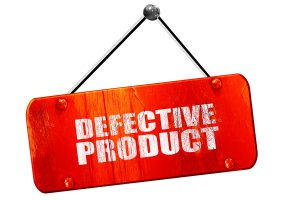Who's Responsible When You’re Injured By A Product?
 Michael Babboni
Personal Injury
Recalls
As consumers, when we buy a product, we are implicitly putting our trust in the company that manufactured it to provide us with a safe product. Unfortunately, there are a variety of factors that result in unsafe products making their way to store shelves.
Michael Babboni
Personal Injury
Recalls
As consumers, when we buy a product, we are implicitly putting our trust in the company that manufactured it to provide us with a safe product. Unfortunately, there are a variety of factors that result in unsafe products making their way to store shelves.In some cases, companies, driven by economic calculations, will intentionally design less than safe products, knowing that the injuries that result will cost less than the profits to be made. In other cases, companies will design a safe product, but a few of the products will make it to shelves with defects that cause injuries. In yet still other cases, companies make products, such as power tools, that are dangerous by design.
Product liability laws hold companies liable for injuries that result from defective products. In the modern economy, a single company is seldom responsible for the entire production process of a product. There are parts suppliers, manufacturing companies, design and branding companies, distributors, and retailers. Liability for a defective product can extend to one or more of these companies involved in the production.
The laws encourage each of these companies to make safe products.
The Types of Product Defects
Under Florida law, there are three ways in which a product can be defective:
- Manufacturing defects
- Design defects
- Marketing defects
A manufacturing defect is one in which the defect arises from a glitch in the manufacturing process, poor workmanship, or the use of poor materials in a subset of the products. The assumption in a manufacturing defect case is that there are versions of the product, which were properly manufactured, and therefore not defective.
Examples of manufacturing defects could be a power saw sold with an improperly installed saw blade, a propane tank assembly with a leaky gasket, or a bag of spinach infected with e. coli.
A design defect is one in which the design of the product itself is inherently defective and dangerous. In other words, even if the product is made and used as intended, it will still cause injury.
Examples of design defects include asbestos containing products, infant high chairs without proper restraints, and air bags that cause severe injuries.
A marketing defect is one in which the product itself was properly designed and manufactured, but failed to contain adequate warnings or instructions on its dangers and proper operation.
Examples of marketing defects include pharmaceuticals without proper side effect warnings, microwavable products without proper warnings about burn risks, or power tools without included instructions.
Types Of Product Liability Actions In Florida
With any of these defects, there are two ways an injured party can bring an action against the product manufacturer in Florida:
- Strict Liability
- Negligence
Under Florida’s strict product liability laws, a product manufacturer is liable for injuries to a consumer if it placed a defective or unreasonably dangerous product on the market, and the defect caused an injury.
A product is unreasonably dangerous if it fails to perform as safely as expected when used as intended or in a manner reasonably foreseeable by the manufacturer. A product is also unreasonably dangerous if the danger in the design of the product outweighs the benefits of the design.
Under strict product liability, the injured party does not need to prove the product manufacturer was negligent or careless. It is enough to prove that the product was defective or unreasonably dangerous, and that it actually caused an injury.
Consumers in Florida can also bring a traditional negligence action against product manufacturers, arguing that the manufacturer did not take reasonable steps to ensure the safety of a product.
